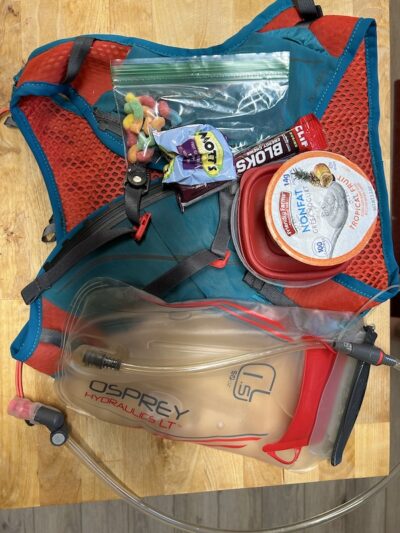Alexis Bennett is an Idaho native who enjoys big hikes and trails with her son and dog. Her street credit includes 20 years of running and weight training experience, including as a collegiate track athlete, finishing the Boise Trail Challenge on foot in 2023, and holding the women’s single-day Boise Grand Slam record.

Eating on the Trail
Who doesn’t love a tasty treat on the trail? I know I do. In fact, on days when I’m not motivated, but know I’ll be happy for some time outside, the treat is the only thing that gets me started.
But I digress.
Nutrition on the trail is important—and not just for overnight trips. Having enough energy to get through your hike or run is not a matter simply of feeling good, it’s also a safety issue. (Those who have experienced the dreaded “bonk” can attest to this.) Not only will you feel better with the fuel to crush your outing, but you’ll also get back to your car without feeling excessively tired, sluggish, or worse, delirious. And, as a bonus, good nutrition seems to improve your body’s ability to recover so you can get back out there sooner!
While throwing a bunch of snacks and water, or food if you’re backpacking, into a sack and calling it good can work, there are other ways to approach trail nutrition. Because I like feeling my best on a run or hike, I plan my food intake carefully. I’ll share the approach I take, which is backed by a great deal of research and trial and error. Disclaimer: While I’ve worked with many professional nutritionists and dieticians, I am not one. So, check with your doctor before you take my advice as gospel and/or if you have a medical condition.
Fuel Sources
First, let’s talk about what’s in food. All food has some combination of what is referred to as macronutrients. It essentially refers to what kind of energy is in that food item: protein, carbohydrates, and fat. Each serves a specific purpose in your daily eating as well as on the trail.
Here’s a quick breakdown:
Protein: These are the building-block nutrients. It’s the nutrient that’s used to repair your body and help you recover, including rebuilding muscle after working out or tissue after you’ve scraped your knee. Protein comes from animal and plant sources including chicken, eggs, yogurt, and beef as well as plant-based options such as lentils, spinach, and quinoa.
Carbohydrates: These are your primary source of both energy and fiber, helping you climb steep hills and process foods for digestion. The confusion around carbs usually has to do with complex versus simple carbs, with the latter often vilified as a cause of weight gain. Hopefully, we can set that aside for now because both have their place. For now, the quick explanation is this: complex carbs are those that have a lot of fiber. Simple carbs are quick-absorbing and usually have natural or artificial sweeteners. Complex carbs help you digest your food and help you feel full. Think of foods that require a lot of chewing, such as broccoli or oatmeal. They’re also usually low in sugar, so not sweet naturally. Simple carbs are usually easier to chew because they have less fiber. Less fiber makes them easier to digest, which means they’re converted to fuel faster (see: boost of energy!). Juice or coconut water, fruit, and sweets are all examples.
But what about bread and bagels? They take a long time to chew and aren’t sweet. Where do they fall in this category. This is where my cheat sheet approach breaks. Bread, rice, pasta, and other processed grains are also simple carbs.
Fat: These are important for hormone and organ regulation and provide long-lasting energy. Examples include nuts, oils, dairy, and avocado.
Food for Purpose
When you’re packing for a day hike, trail run, or backpacking trip, food is critical. You need the energy to safely make it through your planned miles and without bonking, dizziness, or injury. But what you eat, and pack depends primarily on how long you’ll be out, both miles in a day and days in a row, as well as your preferences and dietary needs. This blog from Black Iron Nutrition is an excellent guide for understanding how much food you need to eat based on how long (again, you’ll notice I didn’t say how many miles) you’ll be out. I’m also going to share my loose guidelines, knowing that I’m not a dietician or nutritionist, based on my experience.
Day hikes: Day hikes can range from a few miles over a couple of hours to a full-day getaway. For day hikes, I start my day with a balanced breakfast, like a protein shake and oatmeal with granola and peanut butter. It gives me everything I need to start the day and have sustained energy. In my pack, I like to bring snacks that I’ll get into about an hour into the hike, especially if it’s not strenuous. These snacks are usually some sort of simple carbohydrate, like an apple or fruit snacks. Some people prefer only whole foods so might choose a bagel instead. For lunch, I’ll opt for carbs and fat, such as a peanut butter and jelly sandwich. I’ll snack on my way back, too, if I’m still needing calories (AKA energy). This will depend on the length of the hike (see the blog).
Trail runs: Again, I’ll start with a balanced breakfast. Usually, I’ll skip the protein shake before a run though because I’d rather not have as much liquid sloshing around in my stomach. In my running vest, I’ll pack water and intra-run snacks, primarily simple carbs, but depending on how long I’m out, I may pack some trail mix and pop small handfuls in my mouth as I go.
Backpacking: For backpacking, I like to think about my nutrition and packing in terms of meals and day-trip snacks. I try to eat similar to how I eat at home on a day hike day. For example, I start with oatmeal for breakfast and will usually add peanut butter to it. Then, I’ll make a peanut butter and jelly sandwich for my day-hike lunch. I’ve also been known to pack those pre-made tuna packs with mayo and make a sandwich out of that. (A friendly reminder to hang your trash where predators might be, especially meat like tuna.) For day trip snacks, I’ll pack simple carbs and fat. Backpacking, I tend to bring more bars than I do on day hikes or runs, just because too much sugar over a longer trip makes my stomach hurt. (And you need a lot of calories on the trail, which means potentially a lot of sugar snacks.) I’ll bring Clif or Kind bars, which have some fat and simple carbs as well as some protein for muscle repair. For dinner, I try to replenish my carbs so I have the energy to recover, and will try to find the meals with the most protein.
Use the Black Iron Nutrition blog, or other resources to gain an understanding of how many calories (or energy) you need. While you can get away with undereating on a day hike or trail run, because you can easily replenish at home, backpacking is trickier. You use a lot of energy to get in and out and are likely logging miles during the day. Eat to sustain that effort! It’s also nice to have a little extra food so you don’t go on a complete bender when you get home. (Ask how I know…) So, throw an extra freeze-dried meal or bar in that pack!
Some of my favorite snacks:
- Clif blocks (simple carb)
- Welches fruit snacks (simple carb)
- Sour gummy worms (simple carb)
- Apples (simple carb)
- Individual peanut butter packets (fat)
- Trail mix (fat)
Hydration
A quick word on this. Hydration is super important, even if it doesn’t fall neatly under the eating category. So how much should you bring? This article from REI recommends bringing half a liter (or ~32 ounces) for every hour you’re out. For easier carrying, invest in a hydration pack, but you can also carry water bottles in a backpack for shorter trips. Even on day hikes, it’s never a bad idea to bring some sort of easy-to-use water purifier. You can go weeks without food and only water but only a few days without water. Hopefully, it goes without saying that for overnight trips, a water purification system or iodine tablets are a necessity.
As far as post-run or -hike rehydration, I opt for non-water hydration sources—mostly because I don’t do a great job of drinking enough water on the trail and feel like I’m constantly rehydrating. While I don’t recommend this approach, some of my go-tos are LMNT (only the fruity flavors) and coconut water.





Wonderful information!